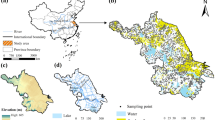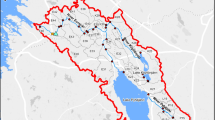Abstract
The application of phosphorus (P)-index methodology to assess the risk of water pollution from agriculture in river basins usually takes time and expends a great amount of resources. This study adapted the P-index methodology using digital mapping of key basin risk criteria for P loss in reference areas to evaluate the wider vulnerability to P loss in a zero-order basin with an intense concentration of pigs and with a history of pig slurry additions to the soil. The P content of eleven reference areas, where ten areas have received various applications of pig slurry and one area has no history of addition, was extrapolated to a zero-order basin using principal component analysis and analysis of hierarchical groupings. Estimated loss of soil and the distance between the P source and the watercourse were mapped using satellite images and in situ evaluations. The methodology of extrapolating was well correlated with a survey of P concentrations in land runoff and provides the potential to improve land management of those areas that are most vulnerable. Principal component analysis and hierarchical clustering analysis proved to be useful tools for the separation of areas with different slurry application times. Our results suggest that the P loss risk could be reduced through the adoption of soil conservation techniques such as reduced-tillage incorporating slurry and crop residue management to provide adequate soil protection, reduce the impact of raindrops and reduce erosion risk and transport of chemical pollutants to water bodies.

Source: Google Earth. December of 2016




Similar content being viewed by others
References
Barbetta PA (2010) Estatística aplicada às ciências sociais, 7ft edn. UFSC, Florianópolis
Beegle DB, Weld JL, Gburek WL, Kleinmar PJA, Sharpley AN (2006) The Pennsylvania phosphorus index: version I. Pennsylvania State University, Pennsylvania
Bertol I, Schick J, Batistela O (2002) Soil loss ratio and C factor for corn and oat in rotation with other crops in three soil tillage types. Rev Bras Cienc Solo 26:545–552. https://doi.org/10.1590/s0100-06832002000200029 (In Portuguese, with English abstract)
Bertol I, Leite D, Guadagnin JC, Ritter SR (2004) Water erosion on an Hapludox submitted to different soil managements under simulated rainfall. II—nutrient and organic carbon losses. Rev Bras Cienc Solo 28:1045–1054. https://doi.org/10.1590/s0100-06832004000600013 (In Portuguese, with English abstract)
Bertol I, Cogo NP, Schick J, Gudagnin C, Amaral AJ (2007) Financial aspects of nutrient losses by water erosion in different soil management systems (In Portuguese, with English abstract). Rev Bras Cienc Solo 31:133–142. https://doi.org/10.1590/s0100-06832007000100014
Bertoni J, Lombardi Neto F (1999) Conservação do solo, 4th edn. Ícone, São Paulo
Caten AT, Minella JPG, Madruga PRA (2012) Disintensification of land use and its relation with soil erosion. R Bras Eng Agríc Ambiental 16:1006–1014. https://doi.org/10.1590/s1415-43662012000900012 (In Portuguese, with English abstract)
Ceretta CA, Basso CJ, Vieira FCB, Herbes MG, Moreira ICL, Berwanger AL (2005) Pig slurry: I—nitrogen and phosphorus losses by surface run off in a soil cropped under no tillage. Ciênc Rural 35:1296–1304 (In Portuguese, with English abstract)
Conforti M, Buttafuoco G, Leone AP, Aucelli PPC, Robustelli G, Scarciglia F (2013) Studying the relationship between water-induced soil erosion and soil organic matter using Vis–NIR spectroscopy and geomorphological analysis: a case study in southern Italy. Catena 110:44–58. https://doi.org/10.1016/j.catena.2013.06.013
Couto RR, Santos M, Comin JJ, Martini LCP, Gatiboni LC, Martins SR, Filho PB, Brunetto G (2015) Environmental vulnerability and phosphorus fractions of areas with pig slurry applied to the soil. J Environ Qual 44:162–173. https://doi.org/10.2134/jeq2014.08.0359
Couto RR, Lazzari CJR, Trapp T, De Conti L, Comin JJ, Martins SR, Filho PB, Brunetto G (2016) Accumulation and distribution of copper and zinc in soils following the application of pig slurry for three to thirty years in a microwatershed of southern Brazil. Arch Agron Soil Sci 62:593–616. https://doi.org/10.1080/03650340.2015.1074183
Dodd RJ, Sharpley AN (2016) Conservation practice effectiveness and adoption: unintended consequences and implications for sustainable phosphorus management. Nutr Cycl Agroecosyst 104:373–392. https://doi.org/10.1007/s10705-015-9748-8
Gatiboni LC, Smyth TJ, Schmitt DE, Cassol PC, Oliveira CMB (2016) Soil phosphorus thresholds in evaluating risk of environmental transfer to surface waters in Santa Catarina, Brazil. Revista Brasileira de Ciência do Solo 39:1225–1234
Hedley MJ, Stewart JWB, Chauhan BS (1982) Changes in inorganic and organic soil phosphorus fractions induced by cultivation practices and by laboratory incubations. Soil Sci Soc Am J 46:970–976. https://doi.org/10.2136/sssaj1982.03615995004600050017x
Hirabayashi S, Kroll C (2007) Automating regional descriptive statistic computations for environmental modelling. Comput Geosci 33:457–464. https://doi.org/10.1016/j.cageo.2006.06.013
Hua K, Zhang W, Guo Z, Wang D, Oenem O (2016) Evaluating crop response and environmental impact of the accumulation of phosphorus due to long-term manuring of vertisol soil in northern China. Agric Ecosyst Environ 219:101–110. https://doi.org/10.1016/j.agee.2015.12.008
ICEPA—Institute of Planning and Agricultural Economics of Santa Catarina (2004) Annual summary of agriculture of Santa Catarina, 2003–2004. ICEPA, Florianópolis (In Portuguese)
Jolliffe IT (2002) Principal component analysis, 3rd edn. Springer series in statistics, New York
Kibet LC, Blanco-Canquia H, Jasa P (2016) Long-term tillage impacts on soil organic matter components and related properties on a Typic Argiudoll. Soil Tillage Res 155:78–84. https://doi.org/10.1016/j.still.2015.05.006
Lagacherie P, Legros JP, Burfough PA (1995) A soil survey procedure using the knowledge of soil pattern established on a previously mapped reference area. Geoderma 65:283–301. https://doi.org/10.1016/0016-7061(94)00040-H
Lemunyon JL, Gilbert RG (1993) The concept and need for a phosphorus assessment tool. J Prod Agric 6:483–486. https://doi.org/10.2134/jpa1993.0483
Lipiec J, Turski M, Hajnos M, Świeboda R (2015) Pore structure, stability and water repellency of earthworm casts and natural aggregates in loess soil. Geoderma 243–244:124–129. https://doi.org/10.1016/j.geoderma.2014.12.026
Lombardi Neto F, Moldenhauer WC (1992) Rainfall erosivity: its distribution and relationship with soil loss at Campinas, state of São Paulo, Brazil (In Portuguese, with English abstract). Bragantia 51:189–196. https://doi.org/10.1590/S0006-87051992000200009
Lopes F, Merten GH, Franzen M, Giasson E, Helfer F, Cybis LFA (2007) Use of P-index in a waterbasin by geoprocessing techniques. (In Portuguese, with English abstract). Rev Bras Eng Agríc Ambient 11:312–317. https://doi.org/10.1590/S1415-43662007000300011
Mannigel AR, Carvalho MP, Moreti D, Medeiros LR (2002) Erodibility factor and loss tolerance of soils of São Paulo state (Brazil). Acta Sci Maringa 24:1335–1340 (In Portuguese, with English abstract)
McBratney AB, Minasny B, Viscarra RA (2006) Spectral soil analysis and inference systems: a powerful combination for solving the soil data crisis. Geoderma 136:272–278. https://doi.org/10.1016/j.geoderma.2006.03.051
Mori HF, Favaretto N, Pauletti V, Dieckow J, Santos WL (2009) Water, soil and phosphorus loss after cattle slurry application to oxisol under no-tillage and simulated rainfall. Rev Bras Ci Solo 33:189–198. https://doi.org/10.1590/s0100-06832009000100020 (In Portuguese, with English abstract)
Murphy J, Riley JP (1962) A modified single solution method for the determination of phosphate in natural waters. Anal Chim Acta 27:31–36. https://doi.org/10.1016/S0003-2670(00)88444-5
Nelson NO, Shober AL (2012) Evaluation of phosphorus índices after twenty years of science and development. J Environ Qual 41:1703–1710. https://doi.org/10.2134/jeq2012.0342
Saadat H, Adamowski J, Tayefi V, Namdar M, Sharifi F, Ale-Ebrahim S (2014) A new approach for regional scale interrill and rill erosion intensity mapping using brightness index assessments from medium resolution satellite images. Catena 113:306–313. https://doi.org/10.1016/j.catena.2013.08.012
Sharpley A, Weld J, Beegle D, Kleinman P, Gburek W, Moore P, Mullins G (2003) Development of phosphorus indices for nutrient management planning strategies in the united states. J Soil Water Conserv 58:137–152
Soil Survey Staff (2006) Soil taxonomy: a basic system of soil classification for making and interpreting soil surveys. In: Agriculture handbook, vol 436, 2nd edn. U.S. Gov. Print. Office, Washington
Tavares MR, Belli Filho P, Coldebella A, Oliveira PAV (2014) Water disappearance and manure production at commercial growing-finishing pig farms. J Livest Sci 169:146–154. https://doi.org/10.1016/j.livsci.2014.09.006
Tedesco MJ, Gianello C, Bissani CA, Bohnen H, Volkweiss SJ (1995) Análise de solo, plantas e outros materiais. 2nd edn. Bol. Téc. 5. Dep. de Solos, Univ. Federal do Rio Grande do Sul, Porto Alegre, Brazil
Ten Caten A, Dalmolin RSD, Pedron FA, Santos MLM (2011) Extrapolation of soil-landscaperelationship from a reference área. Ciênc c 41:812–816. https://doi.org/10.1590/s0103-84782011000500012 (In Portuguese, with English abstract)
Tiecher T, Schenato RB, Santanna MA, Caner L, Rheinheimer DS, (2017) Phosphorus forms in sediments as indicators of anthropic pressures in an agricultural catchment in southern Brazil. Rev Bras Cienc Solo 41:801–814. Ciência Rural 41:1-17. https://doi.org/10.1590/1806965720160569
Weill MAM, Sparovek G (2008) Erosion study in the Ceveiro Watershed (Piracicaba, SP): I. Estimation of soil loss rates and sensitivity factor analysis of the USLE model (In Portuguese, with English abstract). Rev Bras Cienc Solo 32:801–814. https://doi.org/10.1590/S0100-06832008000200034
Weld JL, Beegle DB, Gburek WL, Kleinmar PJA, Sharpley AN (2003) The Pennsylvania phosphorus index: Version I. Pennsylvania State University, University Park
Wischmeier WH, Smith DD (eds) (1978) Predicting rainfall erosion losses: a guide to conservation planning. In: Agriculture Handbook, vol 537. USDA, Washington
Withers PJA, Neal C, Jarvie HP, Doody DG (2014) Agriculture and eutrophication: where do we go from here? Sustainability 6:5853–5875. https://doi.org/10.3390/su6095853
Yang Q, Tian H, Xia L, Ren W, Zhang B, Zhang X (2016) Julie Wolf spatiotemporal patterns of livestock manure nutrient production in the conterminous United States from 1930 to 2012. Sci Total Environ 541:1592–1602. https://doi.org/10.1016/j.scitotenv.2015.10.044
Zawadzka J, Mayr T, Bellamy P, Corstanje R (2015) Comparing physiographic maps with different categorisations. Geomorphology 231:94–100. https://doi.org/10.1016/j.geomorph.2014.12.006
Acknowledgements
We would like to thank the Social Technologies for Water Management Project (TSGA), the National Council for Scientific and Technological Development (CNPq) and the Coordination for the Improvement of Higher Education Personnel (CAPES).
Author information
Authors and Affiliations
Corresponding author
Rights and permissions
About this article
Cite this article
da Rosa Couto, R., Martini, L.C.P., Gatiboni, L.C. et al. Vulnerability to contamination by phosphorus in a zero-order basin with a high density of pigs and a history of slurry addition: extrapolation of an index. Environ Earth Sci 77, 144 (2018). https://doi.org/10.1007/s12665-018-7301-1
Received:
Accepted:
Published:
DOI: https://doi.org/10.1007/s12665-018-7301-1




